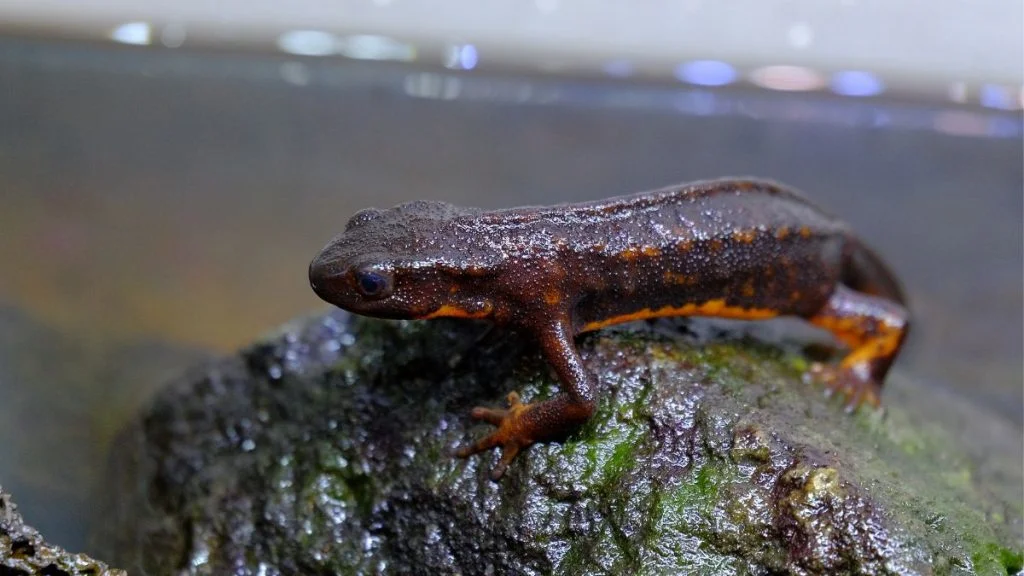The pond is a great home for many animals, not just fishes, and they can be found in different habitats and cut across numerous countries.
They also come in various sizes and can be either natural or man-made.
Animals that live in ponds all have their uniqueness, and we shouldn’t expect sameness from them. These pond animals include fishes, amphibians, reptiles, and mammals that have made a safe space out of ponds. Some are harmless to humans, while some should best be avoided.
Animals that live in lakes and ponds dwell there for several reasons. Let’s take a look at a list of 35 pond inhabitants and what we can learn about each.
List of Animals that Live in Ponds
1. American Toad

- Scientific Name: Anaxyrus Americanus
- Range: Northeast United States, Midwest States
- Classification: Amphibian
- Diet: Carnivore
The American Toad is a popular amphibian that can be found in the United States. It stays close to ponds, and Hollywood animated movies often capture these toads perched on a leaf in shallow waters. (you can try this)
These ponds give them a place to lay eggs, cover for the day, and a good environment to eat at night.
The American Toad has 3 subspecies: the eastern American Toad, the dwarf American Toad, and the Hudson Bay Toad.
The latter is the rarest of the three. Its eggs—that it lays close to the pond—hatches between 2 to 14 days. It feeds on insects, worms, slugs, and mealworms.
2. Beaver
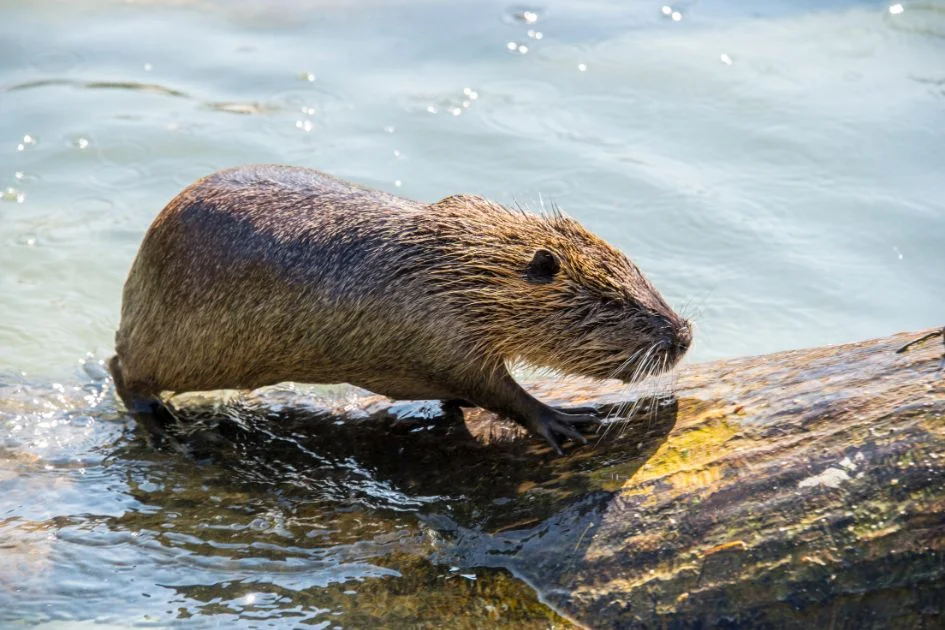
- Scientific Name: Castor
- Range: North America
- Classification: Rodent
- Diet: Herbivore
The Beaver is regarded as semiaquatic, and as such can be found both on land and on fresh water like lakes, streams, rivers, and ponds.
It is known to build dams and lodges. The former help control water while the latter serve as homes. Ponds also give the Beaver a spot to store food for winter.
The Beaver is the second biggest rodent in the world, and it is subdivided into two extant species: the North American Beaver and the Eurasian Beaver.
The Beaver is a herbivore, and it feeds on barks, leaves, twigs, and roots.
3. Three-Spined Stickleback
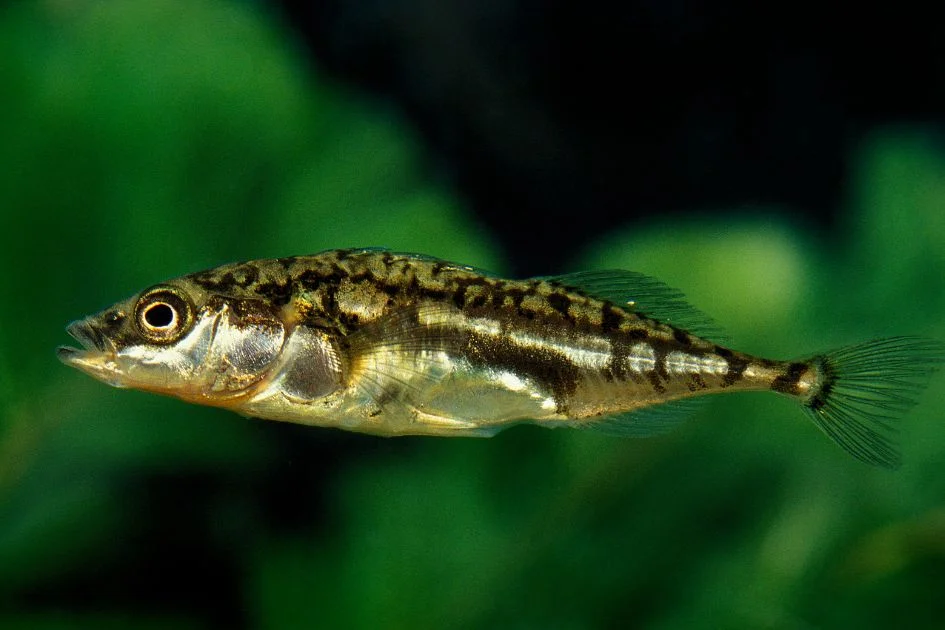
- Scientific Name: Gasterosteus aculeatus
- Range: Brackish and Coastal Freshwater
- Classification: Fish
- Diet: Carnivore
The 3-Spined Stickleback was so named because of the three spines that stick out on its back (three isn’t a definite number however as some have 2 or 4 spines).
The spines are a protective armor against predators. This fish is a predator of its own, though. It can feed on larvae and some other prey that may come from the land.
It is also social and has long held the interest of scientists due to its social nature, variations in the structure, and its ability to live in both seawater and freshwater.
4. Common Blackbird

- Scientific Name: Turdus Merula
- Range: Europe, North Africa, India, Southern China
- Classification: Bird
- Diet: Omnivore
Blackbirds hang around ponds, and in that sense, they can be called pond animals. They love water and would often use them to drink and bathe.
The bird is also known as the Common Blackbird or Eurasian Blackbird. It has many subspecies and can either migrate or settle in its wide range.
As omnivores, blackbirds get their nutrients from both animals and plants. They feed on insects, berries, fruits, and seeds. They tend to be arboreal (on trees) but you can also find them on the ground.
5. Catfish
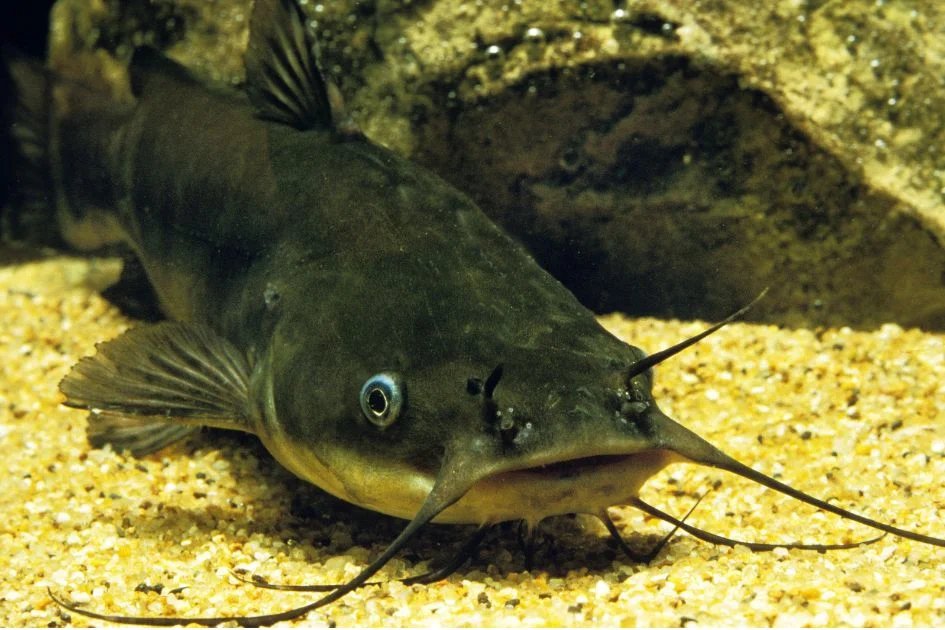
- Scientific Name: Siluriformes
- Range: Worldwide
- Classification: Fish
- Diet: Omnivore
A well-known and recognizable fish, the catfish can be found on every continent except Antarctica. It lives in different bodies of water, from pools to streams. The catfish range in size, from the big ones to the parasitic sizes.
The three biggest catfish species are the Mekong giant catfish, the wels catfish, and the piraiba.
This fish got the name because of its prominent whiskers that resemble those of cats. Not all catfishes have whiskers, however.
Catfishes feed on other fishes, clams, snail plants, and insects. Some catfishes are nocturnal, others are diurnal.
It isn’t always advisable for a human to get into contact with a catfish without sufficient cover. While some are harmless, others pose risks.
6. Canada Goose

- Scientific Name: Branta canadensis
- Range: North America
- Classification: Bird
- Diet: Herbivore
The Canada Goose often stays close to shallow waters, and due to its herbivorous diet, it looks for waters with grasses growing at the edges.
Many ponds have these, and those are where the Canada Goose finds refuge and food. It is native to North America but can migrate to the north of Europe.
It coexists well with humans and would prefer setting up its colonies in urban areas where there are fewer predators than in the wild.
7. Caddisfly

- Scientific Name: Trichoptera
- Range: Worldwide
- Classification: Insect
- Diet: Omnivore
The Caddisfly refers to a group of insects consisting of more than 14,000 species. They are very small insects, getting between 1 and 2 inches long.
They love being close to water, especially still ones like ponds, but fast waters are also important to them during the larvae stage.
Caddisflies can be found worldwide as they have a vast range. The larvae are aquatic, while the adult is terrestrial. They look a bit like moths, but in insect form.
The Caddisfly is an omnivore, but it feeds more like a larva than an adult. A good number of adults don’t feed in their short lives.
8. Leech
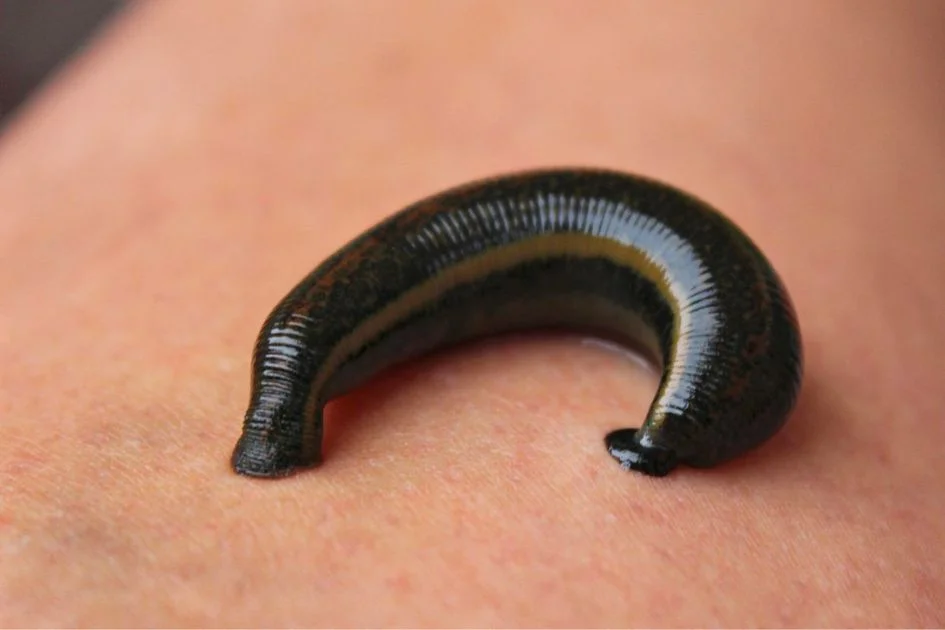
- Scientific Name: Hirudinea
- Range: Worldwide
- Classification: Annelida
- Diet: Omnivore
The leech has a bad reputation, and it isn’t hard to see why. It attaches itself to an animal (frogs, birds, fish, lizards…) and feeds on the blood.
Worse, its saliva stops blood from clotting, leading to further issues for the host. Not surprisingly, the leech is a representation of a greedy person.
This parasitic animal isn’t dangerous to humans, and its bite is just more hurting than fatal.
However, some people are allergic to the bite and would need medical attention. Plus, who would want to have their blood sucked out?
9. Largemouth Bass

- Scientific Name: Micropterus salmoides
- Range: North Carolina, Mexico, Florida
- Classification: Fish
- Diet: Omnivore
The Largemouth Bass spreads through North America, from the United States down to Mexico.
It has also been introduced in other places and it has a lot of names across the regions where it lives.
Some of the names are Widemouth bass, bigmouth bass, black mouth, Florida bass, green bass, and bucket mouth.
This fish can be found in freshwater, which includes ponds and lakes. It preys on small fishes, insects, earthworms, shrimps, snakes, frogs, small mammals, etc.
The female Largemouth Bass is usually bigger than the male.
10. Eurasian Water Shrew
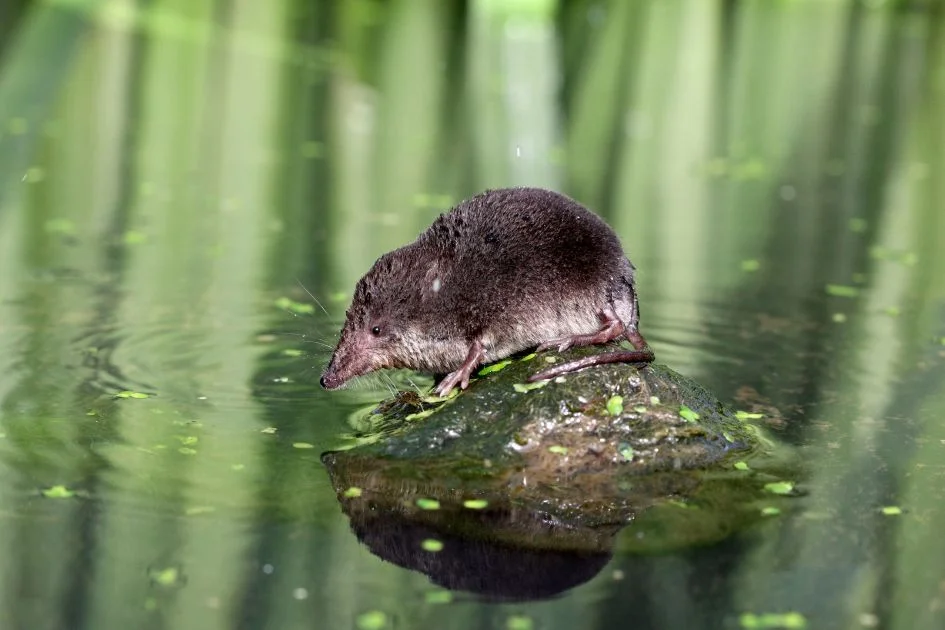
- Scientific Name: Solex palustris
- Range: Northwest South America
- Classification: Mammal
- Diet: Omnivore
The Eurasian Water Shrew—simply called Water Shrew in the United States—is a large shrew, and its name points to its ability to adapt to water.
They live on water surfaces on which they build nests for resting and raising their young ones.
While its preference seems to be freshwater, it can also be found hunting close to seawater.
The water shrew is one of the few venomous mammals due to its saliva, but it can’t bite through a human’s skin (fortunately) nor that of a mammal.
The venom is reserved for its prey, like the crayfish, the water snail, the aquatic larvae, spiders, amphibians, and insects.
11. Koi Fish
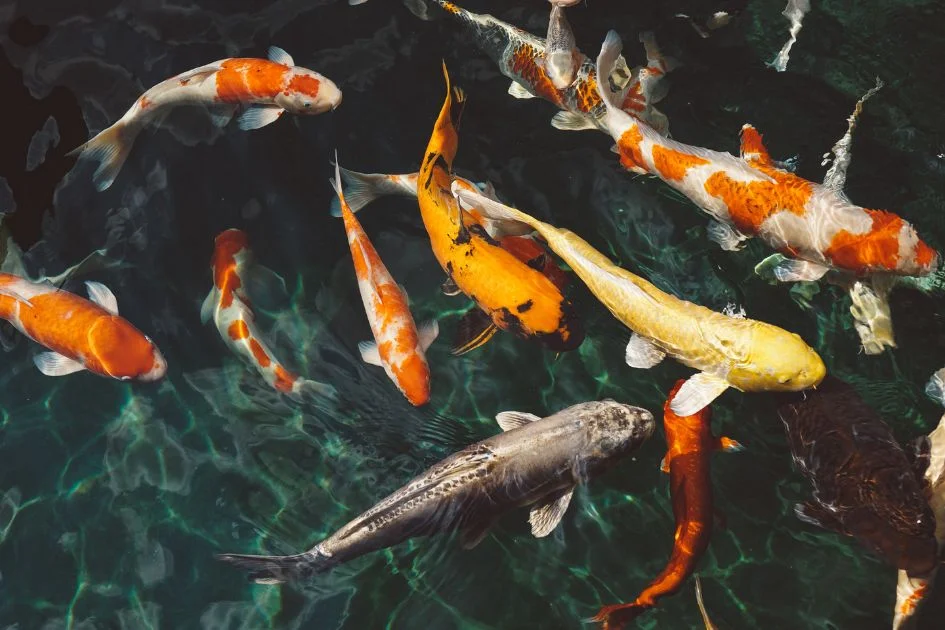
- Scientific Name: Cyprinus rubrofuscus
- Range: Worldwide
- Classification: Fish
- Diet: Carnivore
The Koi Fish stands out with its color variations, and together they form a multi-colored wonder. Koi fishes are considered old.
They were domesticated over 2000 years back, and they remain domestic to a large extent.
They are comfortable around humans, have no wariness for predators, and are often found in outdoor ponds or water gardens. Hardly would any be in a wild pond.
The Koi Fish is similar to some varieties of goldfish, and they both originated in Asia before spreading all over the world.
In Japan, people consider Koi a sign of good luck, prosperity, good fortune, and perseverance.
12. Common Kingfisher

- Scientific Name: Alcedinidae
- Range: Australia, Africa, Asia
- Classification: Bird
- Diet: Omnivore
The Kingfisher is a family of birds, all known for their bright colors. With 3 subfamilies, 19 genera, and 114 species, the Kingfisher is a large family indeed.
The popular Kingfisher species often found close to water is the Common Kingfisher.
Common Kingfishers are hunters, and their favorite hunting spot is close to ponds and other water bodies.
It is also named the Eurasian Kingfisher or the river Kingfisher. It feeds on fishes that it sights from above and it uses the beak to impale its target.
13. Dragonfly
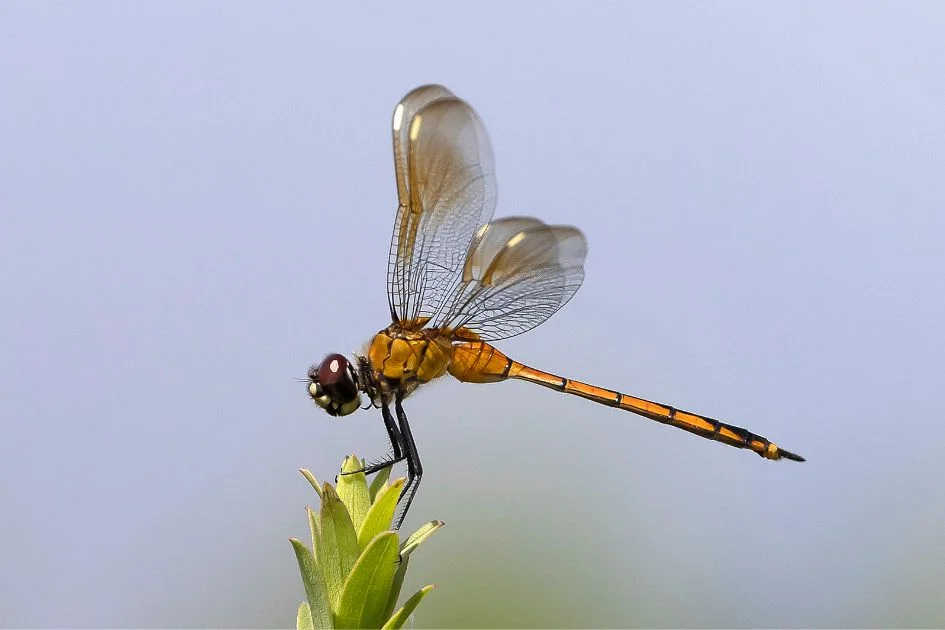
- Scientific Name: Anisoptera
- Range: Worldwide
- Classification: Insect
- Diet: Carnivore
No doubt you’ve seen a dragonfly before. It can be found on every continent except Antarctica, and still, water attracts a lot of dragonflies, including ponds.
Unlike many other insects, dragonflies are predators, and they prey on other insects. One reason they fly close to ponds, rivers, and other water bodies is to find insects to pick up.
Dragonflies live up to 5 years as nymphs, but when they reach adulthood their life expectancy doesn’t get to a year. Some survive for only a few weeks, others live for 5 days.
Some dragonfly species find themselves threatened by habitat loss, but in general, there are still many left.
14. Earthworm

- Scientific Name: Lumbricina
- Range: Worldwide
- Classification: Annelids
- Diet: Omnivore
The Earthworm and leech fall under the same animal type, but the former isn’t as parasitic. It can be found on different continents and can be on land or close to water.
It lives in the soil, and the soil close to the pond provides a good and humid habitat for the earthworm.
This worm feeds on different organic matter, including bacteria, fungi, protozoa, nematodes, and rotifers.
Earthworms have complex reproductive systems. They are hermaphrodites as each earthworm carries both male and female reproductive organs.
15. Frog
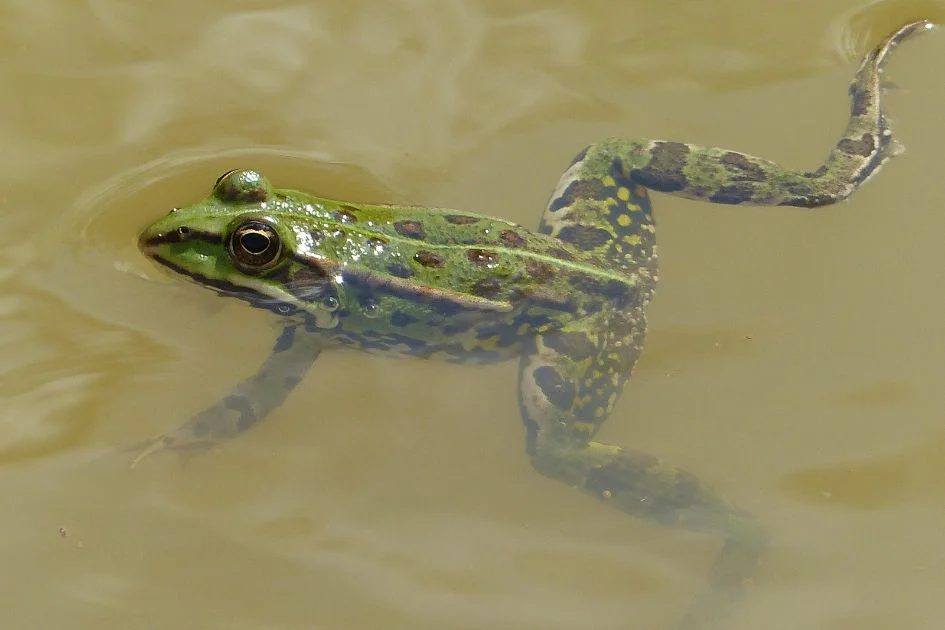
- Scientific Name: Anura
- Range: Worldwide
- Classification: Amphibians
- Diet: Carnivore
The frog looks similar to the toad, and both are classified as amphibians alongside salamanders. The frog is tailless, carnivorous, and some species are poisonous.
These intelligent amphibians are recognized for their distinct croak. It is found on all continents except Antarctica and is very fond of ponds.
Frogs prey on insects, snails, and other invertebrates. They often come out at night, and the long, sticky tongue is their greatest weapon.
Other ways they hunt are through camouflage or the poison on their skin.
16. Heron

- Scientific Name: Ardeidae
- Range: Worldwide
- Classification: Bird
- Diet: Carnivore
While the heron’s main range is in North America, it has also been distributed to other countries in the world.
The heron often stays close to ponds to find food, but it also lives near rivers and lakes. It is well recognized for its long neck and pair of long legs.
The heron is a carnivore, feeding on animals that live close to water. Examples are frogs, fishes, rodents, and waterbirds. Surprisingly, they also hunt baby alligators.
17. Mayfly

- Scientific Name: Ephemeroptera
- Range: Worldwide
- Classification: Insect
- Diet: Omnivore
The Mayfly is a friend of water, and it is often found close to one. It particularly likes ponds because the edges of ponds are often filled with algae which the Mayfly feeds on.
There are over 3,000 Mayfly species in existence, grouped into 400 genera in 42 families.
A quality of the Mayfly that sets it apart is its short lifespan. The Mayfly lives for only 24 hours, after which it dies.
This short lifespan has inspired poetry and other philosophical thoughts. Naturalists are also interested in the life expectancy of the Mayfly.
18. Mallard Duck

- Scientific Name: Anas platyrhynchos
- Range: North America, Eurasia
- Classification: Bird
- Diet: Omnivore
The Mallard Duck lives both on land and on water, and it can be found in North America and Eurasia. Its nest is located close to ponds, and it uses the plants growing as cover.
It also feeds on the lettuces, pondweeds, and seeds of the water lilies at the pond.
Besides water lilies, the Mallard Duck also feeds on insects, worms, crustaceans, seeds, plant matter, roots, and tubers. Some of them also eat frogs.
19. Muskrat
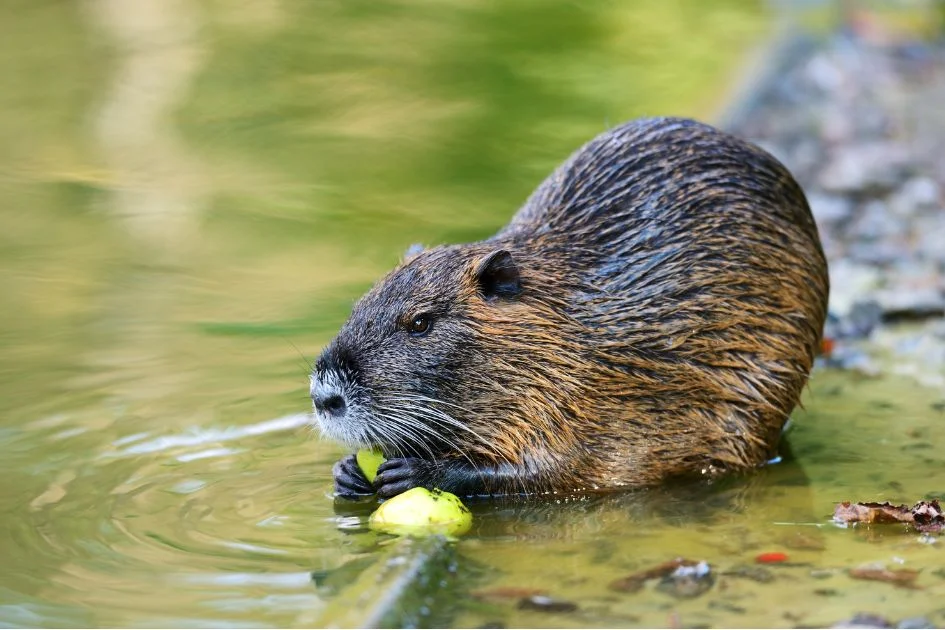
- Scientific Name: Ondatra zibethicus
- Range: Canada, United States
- Classification: Rodents
- Diet: Herbivore
The Muskrat’s home is highly dependent on the plants that grow at the edges of ponds, so the Muskrat can’t be anything more than a pond animal. It can also be found in other water bodies, as well as on land.
It is a semi-aquatic rodent and can remain underwater for 12 to 17 minutes.
This rodent has a social lifestyle similar to humans, as it is grouped in families that consist of a male, a female, and the young.
Members are highly territorial, and it is not uncommon to see them fight over a territory or a potential mate to the point of death. They are gladiators of the rodent world.
20. Mole
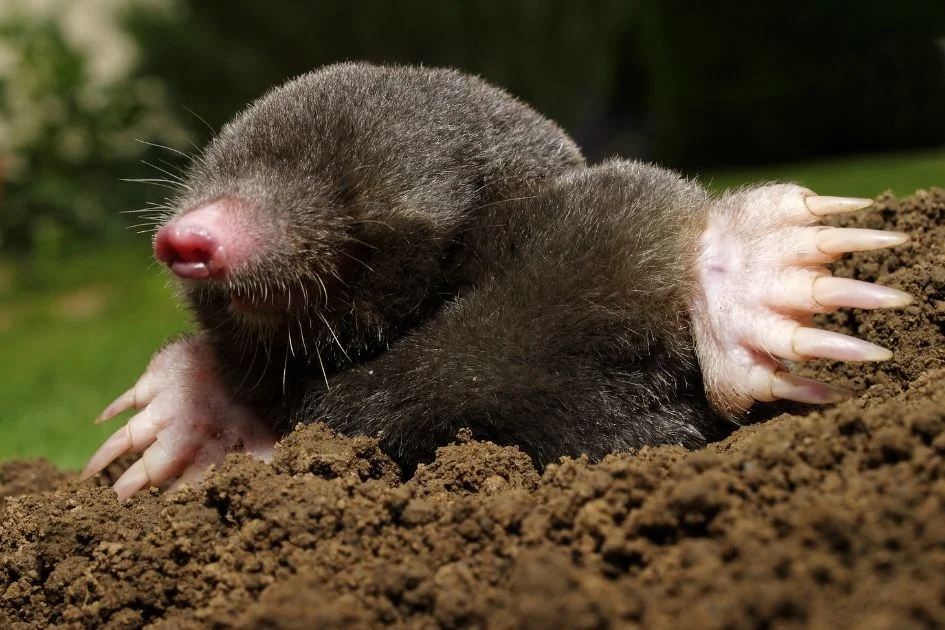
- Scientific Name: Talpidae
- Range: Worldwide except for Antarctica and South America
- Classification: Mammal
- Diet: Carnivore
Moles are underground animals, just as movies and documentaries show. They often remain underground till night when they start their nightly activities.
With tunnels going down 20 feet, moles are strong workers. Because water sources are rich with food, moles dig close to a pond or lake. They prey on earthworms and invertebrates.
They are good at setting traps for the earthworms and even storing them in “larders” for later.
Moles are solitary creatures, adopting an individualistic lifestyle. Their territorial nature doesn’t permit otherwise.
21. Yellow Perch
- Scientific Name: Perca flavescens
- Range: North America
- Classification: Fish
- Diet: Omnivore
The Yellow Perch lives directly in ponds and is a native of North America.
It is sometimes called the perch, striped perch, American perch, American river perch, or preacher. It can also be called the Dodd fish.
Many perch fishes are carnivorous, and they feast on small fishes, larvae, and prawns.
However, not all of these fishes limit their dietary options to animals. Some of them eat plant materials like algae, duckweed, and plantain seeds.
22. Otter
- Scientific Name: Lutrinae
- Range: North America
- Classification: Rodent
- Diet: Carnivore
The Otter lives in ponds and many other water bodies like lakes, seashores, and marshes. There are 13 otter species in existence today, and all are either aquatic, semi-aquatic, or marine.
Otters are part of the Mustelidae family, alongside weasels and badgers.
The Otter is a carnivore that feeds primarily on fish. It can also feed on crabs, frogs, and crayfish as supplements to fish.
That said, they are adaptable and can eat plants when need be.
23. Newt
- Scientific Name: Plurodelinae
- Range: North America, Europe, Asia, North Africa
- Classification: Reptile
- Diet: Carnivore
Newts are often found around ponds, much more than other water bodies. It is a salamander that’s semiaquatic, and there are over 100 Newt species found on different continents, from America to Africa down to Europe.
Sadly, Newts face a lot of threats with many species being endangered. Newts are carnivores and feed primarily on insects. They supplement that with toads and tadpoles.
Newts can also be a prey, and they protect themselves against predators by releasing a toxin. The toxins of certain Newt species can be fatal to humans, so they should be handled with care.
24. Minnow
- Scientific Name: Phoxinus Phoxinus
- Range: Worldwide
- Classification: Fish
- Diet: Omnivore
Minnows can be found all over the world and make a home out of ponds. The Minnow refers to a group of small freshwater fish species, called Pinkeens in Ireland.
These fishes are omnivores as they rely on both plants and animals as diets. They feed on mosquitoes, algae, crustaceans, fish eggs, smaller fishes, etc.
Minnows are also prey because of their small sizes and are eaten by some bigger fishes. Humans feed on them too.
25. Pond Skater
- Scientific Name: Gerridae
- Range: Worldwide
- Classification: Insect
- Diet: Omnivores
The Gerridae is a family of insects with a unique ability to walk on the surface of the water. They are called Pond skaters, but that’s not the only name used to describe them.
These insects can also be called Water Striders, Water Skeeters, Water Bugs, Water
Pond Skaters around any water surface, from pools to lakes.
They have been the subject of studies to ascertain what makes it possible for them
These insects are omnivores, feeding on invertebrates like spiders and smaller insects.
26. Water Scorpion
- Scientific Name: Nepidae
- Range: Worldwide
- Classification: Insect
- Diet: Carnivore
Not to be confused with actual scorpions, the Water Scorpion is a group of insects that were given this name because they resemble scorpions.
These insects can be found on all continents excluding Antarctica, and love to float around ponds, lakes, and ditches, among others.
Water scorpions do bite, though it is mild to humans compared to the sting from a real scorpion. These insects are carnivorous, feasting on other insects that stay on surfaces
27. Water Beetle
- Scientific Name: Hydrophilidae
- Range: Worldwide
- Classification: Insects
- Diet: Herbivores
The Water Beetle is a term for beetles that can live in water. The majority live in freshwater, including ponds. Up to 2,000 Water Beetle species exist, and they can be found all over.
Because there are different Water Beetle species, there is a variety of dietary needs. Some Water Beetles are herbivores and they feed on only plant material like algae, vegetation, or leaves.
We also have the scavengers that feed on decomposing materials, then carnivorous predators that feed on worms, tadpoles, and small fishes
28. Tadpole
- Scientific Name: Anura
- Range: Worldwide
- Classification: Amphibian
- Diet: Omnivore
The Tadpole is a growing amphibian, much like the adolescent stage in the life of a human. Many animals go through life stages as they evolve into adults, and before they mature they get to larvae form.
The Tadpole is the larvae of an amphibian. Most (but not all) tadpoles are aquatic, and they differ from adult amphibians with their gills, tails, and lateral lines.
The dietary needs of tadpoles vary. Frogs are usually herbivorous, and they only become carnivorous after maturing. Salamander tadpoles are carnivorous, and remain so after growth.
29. Common Snapping Turtle
- Scientific Name: Chelydra Serpentina
- Range: Canada, the Rocky Mountains, Florida, Nova Scotia
- Classification: Reptile
- Diet: Omnivore
The Common Snapping Turtle has its roots in North America and is a specie of freshwater turtle all under the Chelydridae family.
The Common Snapping Turtle is the most popular of the family, and it has the farthest range. This species is an omnivore, and its diet incorporates both plants and animals.
They are good predators, able to prey on anything that can be swallowed. Invertebrates, fishes, and frogs are some prey of the Common Snapping Turtle.
30. Ramshorn Snail
- Scientific Name: Planobarius Corneus
- Range: Florida
- Classification: Mollusca
- Diet: Herbivore
The Ramshorn Snail is a term that can either refer to a group of freshwater snails with shells that coil, or the gastropods (snails and slugs) of the Planorbidae family with coiled shells.
In any case, snails with coiled shells are more likely Ramshorn Snails. They are usually herbivores, feeding on algae and other water-based plants. They can also eat dead fish and fish food.
These snails breed easily because of their hermaphroditic nature, and in aquariums, they can become so numerous, that they would be considered pests.
31. Sculpin
- Scientific Name: Cottoidea
- Range: Ozarks of Missouri and Arkansas
- Classification: Mollusca
- Diet: Carnivore
Sculpins like cool water, and ponds provide the exact temperature for them. The habitat isn’t limited to freshwater, though.
Sculpins can also live in oceans. They stay at the bottom of the water, where they feed and survive.
The Sculpin is a carnivore that feeds on invertebrates and small fishes that have the misfortune of living at the bottom too. It belongs to the superfamily Cottoidea and can grow to 4 inches long.
32. Salamander
- Scientific Name: Caudata
- Range: United States
- Classification: Amphibian
- Diet: Carnivore
The Salamander is classified as an amphibian, but has the looks of a lizard, leading to it being sometimes classed as a reptile. There are over 760 living species today, all grouped in 10 extant families.
You will find more in the United States and North America than in other parts of the world. Unlike frogs and toads, salamanders don’t make any noises. However, they have ways of communicating during mating seasons.
They use pheromone signals to attract mates. Salamanders are strong predators and carnivores. They feed on whatever they can grab, like crabs, small mammals, amphibians, and insects.
33. Great Pond Snail
- Scientific Name: Lymnea stagnalis
- Range: European Ponds
- Classification: Mollusca
- Diet: Omnivore
The Great Pond Snail—sometimes simply called the Pond Snail—is a species of freshwater snail that lives in the pond.
It breathes air, but will often be found in ponds and other water bodies like lakes.
The Great Pond Snail feeds on algae, dead plants, and some animals, making it an omnivore. It can be kept as an aquarium pet, though many ones are going free in ponds.
34. Alderfly
- Scientific Name: Sialis lutaria
- Range: Europe
- Classification: Insects
- Diet: Omnivores
The Alderfly is a group of insects in the Megaloptera order, all under the Sialidae family.
There are 66 Alderfly species still in existence, and they are all common in the United Kingdom and Europe as a whole.
Alderflies feed on aquatic invertebrates and organic matter. Thus, they are classified as omnivores, even during the larvae stage.
35. Damselfly
- Scientific Name: Zygoptera
- Range: Worldwide
- Classification: Insects
- Diet: Carnivorous
A Damselfly is a group of insects that shares some similarities with the dragonfly.
These insects exist in all parts of the world except Antarctica, and they are often found hovering over ponds, searching for the next meal.
Some damselfly species are the Beautiful demoiselle and the Bluetail damselfly.
Damselflies feed primarily on smaller insects like flies, mosquitoes, and their legs are their biggest weapons.
Final Thoughts
Ponds and other freshwater bodies are good habitats for different animals.
Some live underwater, others on the surface, and there’s the third category that hovers around the pool. Usually, the latter comprises birds and insects.
All the features in this list of animals that live in ponds have their part to play in the ecosystem as a whole.
